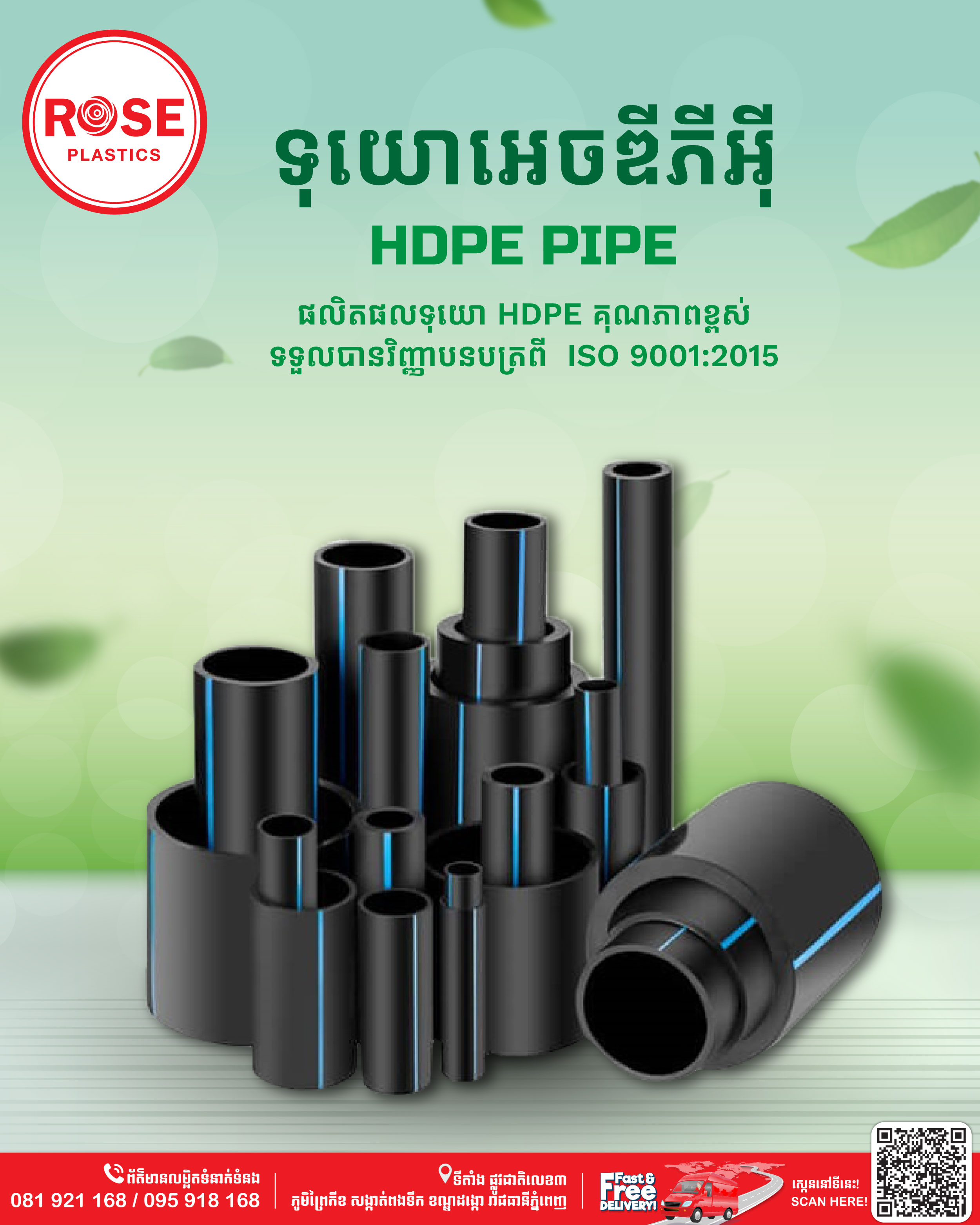HDPE PIPE
What's HDPE PIPE ?
HDPE pipes, or High-Density Polyethylene pipes, are a type of plastic piping commonly used in various applications such as water supply, drainage systems, gas distribution, and more. These pipes are known for their durability, flexibility, and resistance to corrosion, making them a popular choice for many construction projects.
There are several advantages to using HDPE (High-Density Polyethylene) pipes in various applications:
1. Durability: HDPE pipes are known for their high durability and resistance to corrosion, making them suitable for long-term use in different environments.
2. Flexibility: HDPE pipes are flexible and can be bent without the need for additional fittings, reducing the risk of leaks and improving installation efficiency.
3. Lightweight: HDPE pipes are lightweight compared to traditional materials like metal or concrete pipes, making transportation and installation easier and more cost-effective.
4. Chemical Resistance: HDPE pipes have excellent resistance to chemicals, making them suitable for applications where exposure to corrosive substances is a concern.
5. Low Maintenance: HDPE pipes require minimal maintenance over their lifespan, reducing overall operational costs.
6. Smooth Interior Surface: HDPE pipes have a smooth interior surface that promotes efficient flow of fluids and reduces the risk of clogs or blockages.
7. Environmentally Friendly: HDPE pipes are recyclable and can be manufactured from recycled materials, contributing to sustainability efforts.
8. Long Service Life: HDPE pipes have a long service life, reducing the need for frequent replacements and minimizing downtime.
Overall, the advantages of using HDPE pipes make them a popular choice for various applications in industries such as water supply, drainage, gas distribution, and more. Their combination of durability, flexibility, and resistance to corrosion makes them a reliable and cost-effective solution.
There are several common myths about HDPE pipes that need to be debunked:
1. Myth: HDPE pipes are not durable.
Fact: HDPE pipes are highly durable and have a long lifespan. They are resistant to corrosion, abrasion, and chemicals, making them suitable for a wide range of applications.
2. Myth: HDPE pipes are not environmentally friendly.
Fact: HDPE pipes are recyclable and can be made from recycled materials. They have a low carbon footprint and are considered a sustainable choice for piping systems
3. Myth: HDPE pipes are difficult to install.
Fact: HDPE pipes are lightweight and flexible, making them easy to handle and install. They require fewer joints and fittings, reducing the risk of leaks and installation errors.
4. Myth: HDPE pipes are not suitable for high-pressure applications.
Fact: HDPE pipes are designed to withstand high pressures and are commonly used in water distribution, gas transmission, and industrial applications. They have excellent hydraulic properties and can handle a wide range of operating pressures.
5. Myth: HDPE pipes are expensive.
Fact: While the initial cost of HDPE pipes may be higher than some other materials, they offer long-term cost savings due to their durability, low maintenance requirements, and long lifespan. They are a cost-effective choice for many applications.
6. Myth: HDPE pipes cannot handle extreme temperatures.
Fact: HDPE pipes have a wide temperature range and can handle both hot and cold fluids. They are suitable for use in a variety of climates and environments, from freezing temperatures to high heat conditions.
By debunking these myths and understanding the true benefits of HDPE pipes, it becomes clear that they are a reliable and versatile piping solution for a wide range of applications.
High-Density Polyethylene (HDPE) pipes are versatile and widely used in various applications due to their durability, flexibility, and resistance to corrosion. Here are some of the diverse applications of HDPE pipes:
1. Water Supply: HDPE pipes are commonly used for water supply systems in municipal, industrial, agricultural, and residential settings. They are resistant to corrosion, chemical erosion, and have smooth inner walls that allow for efficient flow of water.
2. Gas Distribution: HDPE pipes are also used for the distribution of natural gas and other gases. They are lightweight, flexible, and have excellent resistance to chemicals, making them a safe and reliable choice for gas distribution networks.
3. Sewage and Drainage Systems: HDPE pipes are ideal for sewage and drainage systems due to their smooth interior surface, which prevents clogging and allows for efficient flow. They are also resistant to biological growth and chemicals commonly found in sewage.
4. Irrigation: HDPE pipes are widely used in agricultural irrigation systems due to their flexibility, durability, and resistance to UV radiation. They are available in various sizes and can be easily installed in field irrigation systems.
5. Industrial Applications: HDPE pipes are used in various industrial applications such as chemical processing, mining, and power generation. They can transport a wide range of fluids and chemicals safely due to their high chemical resistance.
6. Geothermal Heating Systems: HDPE pipes are used in geothermal heating systems to transfer heat from the ground to buildings. They are ideal for this application due to their thermal conductivity, flexibility, and resistance to corrosion.
7. Telecommunication and Fiber Optic Networks: HDPE pipes are used for underground ducting in telecommunication and fiber optic networks. They provide protection to cables and can be easily installed using trenchless technology methods.
8. Landfill and Leachate Collection Systems: HDPE pipes are used in landfill and leachate collection systems to transport contaminated liquids and gases safely. They are resistant to chemicals and provide long-term performance in harsh environmental conditions.
Overall, HDPE pipes offer a cost-effective and reliable solution for a wide range of applications across various industries due to their superior properties and performance.
Installing High-Density Polyethylene (HDPE) pipes requires careful planning and execution to ensure a successful and long-lasting system. Here is a guide to HDPE pipe installation:
1. Design and Planning:
- Determine the required pipe size, pressure rating, and material specifications based on the application.
- Plan the layout of the pipeline, including the alignment, depth, and support requirements.
- Consider factors such as soil conditions, environmental conditions, and any potential obstacles or utilities in the installation area.
2. Material Handling:
- Handle HDPE pipes with care to prevent damage to the pipe ends or surface.
- Store pipes in a flat, well-supported area to prevent deformation or bending.
- Inspect pipes for any visible defects or damage before installation.
3. Preparation:
- Clear the installation area of any debris, rocks, or sharp objects that could damage the pipes.
- Excavate the trench to the required depth and width according to the design specifications.
- Ensure the trench bottom is smooth and free of sharp objects that could puncture the pipe.
4. Installation:
- Lower the HDPE pipes into the trench using appropriate lifting equipment to prevent damage.
- Join the pipes using butt fusion, electrofusion, or mechanical fittings as per the manufacturer's recommendations.
- Ensure proper alignment and support of the pipes to prevent stress and maintain uniform flow.
5. Backfilling:
- Backfill the trench with suitable material in layers, compacting each layer to provide support and prevent pipe movement.
- Use clean, non-abrasive backfill material to avoid damage to the pipe surface.
- Follow the recommended backfilling procedures to prevent damage to the pipes.
6. Testing and Inspection:
- Conduct pressure testing of the installed pipeline to ensure there are no leaks or defects.
- Inspect the installation for proper alignment, support, and connections.
- Verify that the installation meets the design specifications and industry standards.
7. Protection and Maintenance:
- Protect the installed HDPE pipes from external damage, traffic loads, and environmental factors.
- Implement a regular maintenance schedule to inspect for any signs of damage, wear, or corrosion.
- Follow manufacturer recommendations for cleaning, repair, and maintenance of the HDPE pipes.
By following this guide to HDPE pipe installation, you can ensure a successful and reliable pipeline system that meets the requirements of your application while maximizing the benefits of
Certainly! Here are some case studies showcasing how HDPE pipes have been used in specific projects:
1. Water Supply Project in a Rural Community:
- Project Description: A rural community lacking access to clean water needed a reliable water supply system.
- HDPE Pipe Solution: HDPE pipes were chosen for their durability and resistance to corrosion. They were used to transport water from a nearby source to the community.
- Outcome: The project was successful in providing the community with a sustainable water supply. The flexibility of HDPE pipes allowed for easy installation in challenging terrains, ensuring a reliable water supply for the residents.
2. Gas Distribution Network Expansion:
- Project Description: An urban area required the expansion of its gas distribution network to meet growing demand.
- HDPE Pipe Solution: HDPE pipes were selected for their flexibility, ease of installation, and resistance to corrosion. They were used to extend the gas distribution network to new residential and commercial areas.
- Outcome: The project was completed efficiently and cost-effectively using HDPE pipes. The lightweight nature of the pipes facilitated quick installation, minimizing disruption to the surrounding areas. The gas distribution network expansion was successful in meeting the increased demand for gas services.
3. Irrigation System Upgrade on a Farm:
- Project Description: A farm needed to upgrade its irrigation system to improve water efficiency and crop yield.
- HDPE Pipe Solution: HDPE pipes were chosen for their smooth interior surface, flexibility, and resistance to UV radiation. They were used to replace old irrigation pipes and optimize water distribution across the farm.
- Outcome: The farm experienced improved water efficiency and crop yield after the installation of HDPE pipes. The durability of the pipes ensured long-term performance, reducing maintenance costs and enhancing the overall irrigation system efficiency.
4. Industrial Chemical Processing Plant Expansion:
- Project Description: An industrial chemical processing plant required the expansion of its piping infrastructure to accommodate increased production capacity.
- HDPE Pipe Solution: HDPE pipes were selected for their chemical resistance and durability. They were used to transport various chemicals within the plant, ensuring safe and efficient operations.
- Outcome: The plant expansion was successful, and the use of HDPE pipes contributed to the seamless operation of the chemical processing facilities. The corrosion-resistant properties of HDPE pipes prevented leaks and maintained the integrity of the chemical transport system.
These case studies highlight the versatility and effectiveness of HDPE pipes in a variety of projects across different industries. The superior properties of HDPE pipes make them a reliable choice for water supply, gas distribution, irrigation, industrial applications,
Maintaining and repairing HDPE pipes is essential to ensure their long-term performance and reliability. Here are some guidelines for maintaining and repairing HDPE pipes:
Maintenance:
1. Regular Inspections: Conduct regular visual inspections of HDPE pipes to check for any signs of damage, leaks, or corrosion. Inspections can help identify potential issues early on and prevent major problems.
2. Cleaning: Keep the interior of HDPE pipes clean to prevent clogging and buildup of debris. Regular flushing with water or appropriate cleaning solutions can help maintain the smooth flow of fluids.
3. Protective Coatings: Consider applying protective coatings to HDPE pipes to enhance their resistance to UV radiation and chemical exposure. Coatings can extend the lifespan of the pipes and improve their performance in harsh environments.
4. Temperature Monitoring: Monitor the temperature of fluids transported through HDPE pipes to prevent overheating or freezing, which can affect the integrity of the pipes. Implement temperature control measures as needed to ensure optimal performance.
5. Avoid Physical Damage: Take precautions to prevent physical damage to HDPE pipes, such as avoiding heavy machinery or vehicles driving over them. Protect the pipes during construction activities to minimize the risk of accidental damage.
Repair:
1. Leak Detection: If a leak is detected in an HDPE pipe, promptly locate the source of the leak using appropriate detection methods. Pinpointing the exact location of the leak is crucial for effective repair.
2. Repair Techniques: Depending on the size and severity of the damage, various repair techniques can be used for HDPE pipes, such as electrofusion welding, butt fusion welding, or mechanical couplings. Select the appropriate repair method based on the specific requirements of the project.
3. Professional Assistance: For complex repairs or large-scale damage, seek the assistance of qualified professionals with experience in working with HDPE pipes. Professional repair services can ensure the proper restoration of the pipes and prevent future issues.
4. Quality Materials: Use high-quality repair materials and components that are compatible with HDPE pipes to ensure the integrity of the repair. Follow manufacturer guidelines for repair materials and techniques to maintain the performance of the pipes.
5. Testing and Inspection: After completing repairs on HDPE pipes, conduct testing and inspections to verify the effectiveness of the repair. Pressure testing and visual inspections can help confirm that the repaired section of the pipe is functioning properly.
By following these maintenance and repair guidelines, you can ensure the longevity and reliability of HDPE pipes in various applications. Regular maintenance, timely repairs, and proper handling can help maximize the performance of HDPE pipes and minimize the risk of disruptions failures.













